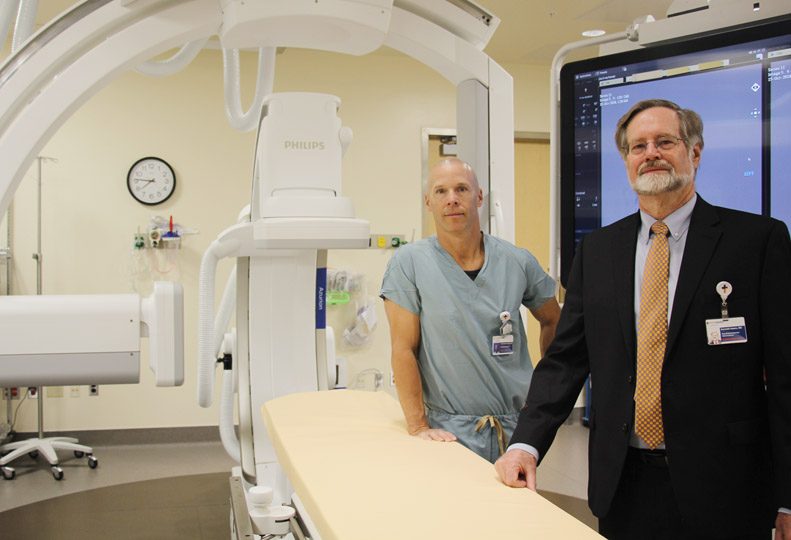
Home » Sacred Heart rebuilds interventional radiology suite
Sacred Heart rebuilds interventional radiology suite
New technology to benefit stroke sufferers, others

October 25, 2018
New equipment, software, and technology in the recently rebuilt interventional radiology suite at Providence Sacred Heart Medical Center, in Spokane, will aid in administering the latest in treatment techniques that can preserve brain functions in areas affected by stroke, says Dr. Kenneth Isaacs, regional medical director of neuroscience with the Providence Spokane Neuroscience Institute.
Isaacs says the redevelopment of the 1,520-square-foot suite on floor L1 of Sacred Heart, at 101 E. Eighth, involved a full demolition and build-out of the ceiling, doors, floor, and walls.
New software for the hospital’s computed tomography scanner enables “increased precision of knowing which (stroke) patients will benefit from clot-busting drugs or the use of clot retrieval in the interventional radiology suite,” says Isaacs.
Other updated technology enables interventional radiologists to retrieve blood clots in stroke patients using a device that’s guided through blood vessels to the blockage. When successful, the technique restores blood flow and potentially enables brain functions to resume, “reducing the severity and sometimes completely reversing stroke-like symptoms,” he says.
The suite also has equipment to help with cases of subarachnoid hemorrhage, says Isaacs. The condition is caused by a ballooning artery or aneurysm. Interventional radiologists can enter that artery through a catheter and patch ruptures or prevent further ballooning.
According to John Hopkins Medicine’s website, interventional radiology is a radiology subspecialty that uses “minimally-invasive, image-guided procedures to diagnose and treat diseases in nearly every organ system.”
Dr. Chris Zylak, director of neurointerventional and interventional radiology for Inland Imaging Associates LLC, says the interventional radiology suite helps a variety of people, not just stroke patients. The suite is ideal for some cancer treatments, handling blood clots in various parts of the body, and treating some trauma and fractures.
Isaacs says a national study known as DAWN recently has shown some stroke patients can be treated using a catheter-guided clot removal device up to 24 hours after the onset of stroke symptoms.
DAWN is short for Diffusion Weighted Imaging or Computed Tomography Perfusion Assessment with Clinical Mismatch in the Triage of Wake-Up and Late Presenting Strokes Undergoing Neurointervention with Trevo.
Before the study, patients were given a four- to-six-hour window of care depending on the stroke, he says.
Dr. Yi Mao, a neurohospitalist with a fellowship in vascular neurology at Providence Spokane Neuroscience Institute, was involved in that study, says Isaacs.
Isaacs says results of that study started coming out in the second half of 2017, and Providence Spokane Neuroscience Institute already has worked to implement the findings of those results into its care.
Despite the possibility of some patients having more time to receive treatment, Isaacs says it’s still important to bring patients in for treatment as soon as possible.
“Every minute counts, and we’re trying to have strokes taken care of quickly as possible,” he says. “Time is of the essence to restore blood flow to the brain.”
Isaacs says the Providence Telestroke Network also helps stroke patients across the Inland Northwest. The network, which was launched here five years ago, connects 18 hospitals across Eastern Washington, North Idaho, and western Montana, through the use of bedside robots that offsite physicians can control to monitor patients, review medical charts, and consult with attending providers.
Established in 2014, the Providence Spokane Neuroscience Institute is a collection of medical practices, specialists, and facilities that treat issues related to spines, strokes, epilepsy, multiple sclerosis, Parkinson’s disease, brain tumors, and other conditions, says Isaacs.
Latest News Special Report Health Care Technology
Related Articles



